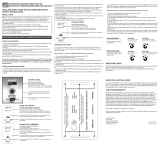
Form I-RDH/REH/RHH/RXH (04-18) PN215210R19, Page 12
NOTE: If your installation includes an optional energy recovery module, a separate eld-supplied roof curb is required
for the energy recovery module.
IMPORTANT Note—Models
RDH, REH, and RXH with
Hot Water Heat: The area
enclosed by the roof curb
must comply with clearance
to combustible materials.
If roof is constructed of
combustible materials, the
area within the curb must
be either ventilated, left
open, or covered with non-
combustible material which
has an “R” value of at least
5.0. If the area within the curb
is left open, higher radiated
sound levels may result.
TABLE 7A - Dimensions and Weights of Optional Roof Curbs for Model RDH, Model REH, and Model
RXH without a hot water heat module (for a Model RXH with a hot water heat module, see TABLE 8A)
Conguration*
Option
Code
RDH Size REH Size
**RXH
Size
Inches (±1/8) mm (±3) Weight
A B C D A B C D lb kg
Basic Unit ONLY (blower and
heat section) with horizontal
discharge
CJ8A
75/100 10A/20A/40A 000A 51-13/16 29-13/16 48-1/16 26-1/16 1,316 757 1,221 662 90 41
125/150 15B/30B/60B 000B 51-13/16 39-13/16 48-1/16 36-1/16 1,316 1,011 1,221 916 101 46
175/200/225 N/A 000C 67-1/2 29-13/16 63-3/4 26-1/16 1,715 757 1,619 662 107 49
250/300 30D/60D/90D/120D 000D 67-1/2 46-1/16 63-3/4 42-5/16 1,715 1,170 1,619 1,075 125 57
350/400A 40E/80E/120E 000E 67-1/2 54-1/16 63-3/4 50-5/16 1,715 1,373 1,619 1,278 134 61
Basic unit PLUS 1: Either
Downturn Discharge Plenum
(AQ5 or AQ8); OR Mixing
Box (MXB1) with horizontal
discharge; OR Cooling Coil
Cabinet without Reheat (AU5 or
AU6) with horizontal discharge
CJ8B
75/100 10A/20A/40A 000A 79-9/16 29-13/16 75-13/16 26-1/16 2,021 757 1,926 662 120 54
125/150 15B/30B/60B 000B 79-9/16 39-13/16 75-13/16 36-1/16 2,021 1,011 1,926 916 131 59
175/200/225 N/A 000C 95-1/4 29-13/16 91-1/2 26-1/16 2,419 757 2,324 662 138 63
250/300 30D/60D/90D/120D 000D 95-1/4 46-1/16 91-1/2 42-5/16 2,419 1,170 2,324 1,075 155 70
350/400A 40E/80E/120E 000E 95-1/4 54-1/16 91-1/2 50-5/16 2,419 1,373 2,324 1,278 164 74
Basic unit PLUS 2: Down
Discharge (AQ 5 or 8) AND
Mixing Box OR Cooling Coil
Cabinet without Reheat (AU 5 or
6); OR Mixing Box AND Cooling
Coil Cabinet without Reheat (AU
5 or 6) with horizontal discharge
CJ8C
75/100 10A/20A/40A 000A 107-5/16 29-13/16 103-9/16 26-1/16 2726 757 2631 662 151 68
125/150 15B/30B/60B 000B 107-5/16 39-13/16 103-9/16 36-1/16 2726 1011 2631 916 162 73
175/200/225 N/A 000C 123 29-13/16 119-1/4 26-1/16 3124 757 3029 662 168 76
250/300 30D/60D/90D/120D 000D 123 46-1/16 119-1/4 42-5/16 3124 1170 3029 1075 186 84
350/400A 40E/80E/120E 000E 123 54-1/16 119-1/4 50-5/16 3124 1373 3029 1278 195 88
Basic unit PLUS 3: Down
Discharge Plenum (AQ5 or AQ8)
AND Mixing Box (MXB1) AND
Cooling Coil Cabinet without
Reheat (AU5 or AU6)
CJ8D
75/100 10A/20A/40A 000A 135-1/16 29-13/16 131-5/16 26-1/16 3431 757 3335 662 181 82
125/150 15B/30B/60B 000B 135-1/16 39-13/16 131-5/16 36-1/16 3431 1011 3335 916 192 87
175/200/225 N/A 000C 150-3/4 29-13/16 147 26-1/16 3829 757 3734 662 199 90
250/300 30D/60D/90D/120D 000D 150-3/4 46-1/16 147 42-5/16 3829 1170 3734 1075 216 98
350/400A 40E/80E/120E 000E 150-3/4 54-1/16 147 50-5/16 3829 1373 3734 1278 225 102
Basic unit PLUS 1: Cooling Coil
Cabinet with Reheat (AU7) with
horizontal discharge
CJ8E
75/100 10A/20A/40A 000A 104-9/16 29-13/16 100-13/16 26-1/16 2656 757 2561 662 149 68
125/150 15B/30B/60B 000B 104-9/16 39-13/16 100-13/16 36-1/16 2656 1011 2561 916 160 73
175/200/225 N/A 000C 120-1/4 29-13/16 116-1/2 26-1/16 3054 757 2959 662 167 76
250/300 30D/60D/90D/120D 000D 120-1/4 46-1/16 116-1/2 42-5/16 3054 1170 2959 1075 184 83
350/400A 40E/80E/120E 000E 120-1/4 54-1/16 116-1/2 50-5/16 3054 1373 2959 1278 193 88
Basic unit PLUS 2: Cooling Coil
Cabinet with Reheat (AU7) AND
Down Discharge Plenum (AQ5
or AQ8) OR Mixing Box (MXB1)
with horizontal discharge
CJ8F
75/100 10A/20A/40A 000A 132-5/16 29-13/16 128-9/16 26-1/16 3361 757 3266 662 180 82
125/150 15B/30B/60B 000B 132-5/16 39-13/16 128-9/16 36-1/16 3361 1011 3266 916 191 87
175/200/225 N/A 000C 148 29-13/16 144-1/4 26-1/16 3759 757 3664 662 197 89
250/300 30D/60D/90D/120D 000D 148 46-1/16 144-1/4 42-5/16 3759 1170 3664 1075 215 98
350/400A 40E/80E/120E 000E 148 54-1/16 144-1/4 50-5/16 3759 1373 3664 1278 224 102
Basic unit PLUS 3: Cooling Coil
Cabinet with Reheat (AU7) AND
Down Discharge Plenum (AQ5
or AQ8) AND Mixing Box (MXB1)
CJ8G
75/100 10A/20A/40A 000A 160-1/16 29-13/16 156-5/16 26-1/16 4066 757 3970 662 210 95
125/150 15B/30B/60B 000B 160-1/16 39-13/16 156-5/16 36-1/16 4066 1011 3970 916 221 100
175/200/225 N/A 000C 175-3/4 29-13/16 172 26-1/16 4464 757 4369 662 228 103
250/300 30D/60D/90D/120D 000D 175-3/4 46-1/16 172 42-5/16 4464 1170 4369 1075 245 111
350/400A 40E/80E/120E 000E 175-3/4 54-1/16 172 50-5/16 4464 1373 4369 1278 254 115
* See Congurations in Paragraph 4.2. NOTE: If there is an evaporative cooling module, the base of the unit under the evaporative cooling
module extends beyond the end of the roof curb. An evaporative cooling module does not aect the length of the roof curb.
FIGURE 8 -
Dimensions of
Optional Roof Curbs
5.0 Mounting and
Lifting (cont’d)
5.2.3 Mounting on a Roof Curb (cont’d)
5.2 Mounting (cont’d)




















